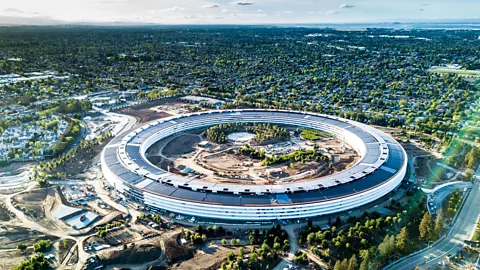Why we shouldn’t try to replicate Silicon Valley
 Getty Images
Getty ImagesThere's an argument to be made against reproducing the Valley and rolling out its culture worldwide.
There’s a global popularity contest going on and I’m not talking about followers on Twitter.
The leaders running the world’s biggest cities are competing to label their city the ‘next Silicon Valley’. From London to Beijing, Tel Aviv to Tallinn, there’s a race to create tech hubs that will lure the very best minds – and investors with the deepest pockets.
But is Silicon Valley and the culture that has evolved around it really what our cites should be striving to emulate and spend tax payers’ money on?
Over the past 60 years, the world has watched the original Silicon Valley morph from a small network of specialised technology manufacturers into the global nucleus of multi-billion-dollar technology. Home to Apple, Google, Facebook, Netflix and many of their cousins, together, these companies are now valued at trillions of dollars.
A data snapshot of the Valley shows a region of 1,854 square miles with just over three million people, 38% of whom were born abroad. Per-capita, Silicon Valley is easily one of the richest places on earth, wealthier than many countries. Its residents earn, on average, $125,580 annually and in 2015, it ranked behind only Zurich and Oslo in terms of per-capita gross domestic product (GDP).
So, it’s easy to understand why others want a piece of this success.
Is there a formula? One attribute that supposedly unites the Valley’s mega-firms is their nimble ability to innovate and grow. But is it really something that can be replicated elsewhere? And even if it can, should it? A melting pot of boom-and-bust start-ups has its downsides.
Someone who thinks the answer may be ‘no’ is innovation expert and consultant, Dan Breznitz, at the University of Toronto. “Think about Silicon Valley – you take a Stanford or MIT graduate, not your average Joe, shower them with money so they might create a company that is successful and become a billionaire,” he says, referring to the occasional success story among the many young start-ups that otherwise go on to fail. “It’s a complete casino.” Although the number of US start-ups that fail is often quoted as high as 90%, a figure nearer to 60% may be closer to the mark – still a high failure rate and risk to investment.
Breznitz argues that, partly because of unique circumstances that created Silicon Valley in the first place - the Californian university research teams that launched early semiconductor firms - the tech hub is probably not a useful model to roll out for innovation centres of the future. As he points out, the Valley took decades to get to where it is now.
Setting up the educational and industrial ecosystem for an innovation hub like that overnight is a tall order. There’s a new mantra for our times: Silicon Valley wasn’t built in a day.
 Getty Images
Getty ImagesComplimentary fields
The analyst makes a sometimes overlooked point: other smart economies around the world have made money already, not by trying to cultivate their own Silicon Valley, but by diversifying and benefiting from the growth of the US one. Take Taiwan, for instance. It has excelled in chip manufacturing – an industry that has piggy-backed on the Valley’s success.
“It is not that the Taiwanese just have fabrication facilities,” explains Breznitz. “They developed technologies around [those facilities] to allow the [hardware] designer to create things more efficiently.” The tech sector in the country is worth around $130 billion. Although, even Taiwan has recently considered experimenting with the innovation-led Silicon Valley route in order to keep up with the pace of change and threat of competition from China.
Building up skills and investing in a specific sector is exactly what keeps German manufacturing dominant in Europe, too. It’s why a German company like Siemens is turning to developing smart manufacturing facilities in China – and not the other way round.
Germany’s famous Fraunhofer Institutes come up with new ways of improving engineering at the country’s largest firms, ensuring they remain competitive. Music hosting site SoundCloud is based in Berlin. And you might be surprised to learn that, for example, the MP3 compression algorithm was invented by Fraunhofer technicians – not Silicon Valley entrepreneurs.
 Getty Images
Getty ImagesSpecialisation
History has many examples of once powerful industrial hubs that were eventually outpaced by foreign rivals. For instance, the rise of Asian shipyards in the 1950s and 1960s, with their new manufacturing techniques and adaptable designs, spelled the end for the British ship-building industry.
Yet some of the pseudo-Silicon Valleys that have sprung up such as Shenzhen in China or Tel Aviv in Israel are making their mark by developing areas of specialisation, argues tech industry analyst Paul Triolo at Eurasia Group.
So while Shenzhen focuses on developing innovations in hardware, Tel Aviv is making a name for itself in cyber-security.
And take London’s so-called Silicon Roundabout with its focus on financial technology (thanks to the large financial sector presence in the city) and artificial intelligence, research very much associated with leading universities like the University of Central London and Imperial College.
“A lot of [the global tech hubs] are more niche whereas the Valley tends to be focused on some of the over-the-top stuff – social media for example,” says Triolo, referring to the large platforms like Facebook or Google that hope to position themselves at the heart of each customer’s digital life.
Valley culture
Tech firms that grow fast will often encounter a playbook of problems. These range from rushed management policies that cause friction among staff to a haphazard approach to protecting users’ personal data.
While the disruptive, rule-book-ripping culture of the Valley has long faced criticism, recent reports of sexual harassment and cover-ups of data breaches have severely damaged some of these firms’ reputations. And a failure to recognise the scale and seriousness of this damage was even recently termed “the other tech bubble” by Wired. Facebook, for instance, is no longer seen as a “merry band of hackers building cutesy tools”, writes Erin Griffith, but a “powerful and potentially sinister collector of personal data”.
Other firms have faced even greater censure. Ride-sharing firm Uber expanded at an astonishing pace on the back of huge investment mostly from venture capital firms but never managed to make a profit. Once a media darling, the firm has been beset by poor management decisions and internal disagreements. Last year, its chief executive took an indefinite leave of absence, after saying he needed “leadership help”.
Tech industry analyst Patrick Imbach at KPMG in London thinks self-regulation will still prove sufficient for the majority of companies and, for the bad apples, “the market will hopefully fix it”. In other words, companies will face action from shareholders, or an investment drought, if they don’t smarten up their act.
Corporate social responsibility (CSR), for one thing is moving up the agenda, it was recently cited as highly important by the world’s biggest investment fund manager, BlackRock. And if the money men are paying attention to CSR then the tech firms need to listen.
One thing Imbach believes we’ll see in 2018, in direct response to the recent scandals, is greater diversity in Silicon Valley boardrooms. That’s one of the “lessons” of recent times, he says: having a board with a more diverse range of views, for example on gender and race issues, is increasingly seen as a valuable asset.
 Getty Images
Getty ImagesThe Chinese model
Perhaps the greatest challenge to the US in the future will come from China, which already has several cities brimming with start-ups, says investor Hans Tung at venture capital firm GGV Capital, pointing to Beijing, Shanghai, Hangzhou and Shenzhen. And the country has its own suite of tech giants, including Alibaba, Tencent and Baidu.
Those Chinese cities are now “rivalling” Silicon Valley, says Tung who believes that in choosing to prioritise start-ups, a society must make some hard choices about its working culture. For example, China’s working culture of long hours, which demands a great deal of employees, has been intensified further as firms have been showered with investment.
And in spite of the hard work, many of these new firms don’t profit – because if there’s one thing that always goes hand-in-hand with a start-up hub, it’s a high proportion of failed ventures. Chinese start-ups certainly appear to fare no better than their counterparts elsewhere in the world. One recent report suggested that 90% of new Chinese virtual reality businesses had declared bankruptcy. It has also become very clear that US businesses launching start-ups in China also often fail to find success. For example, consumer deals site Groupon’s attempt to launch a Chinese subsidiary.
Bubble, bubble?
Many large economies and investors are relaxed about this proliferation of start-up culture and investment in it, a booming tech sector is healthy, they say. But one investment fund manager who does raise some concerns is Robert Naess at Nordea Bank.
Naess explains that in the US, venture capitalists, and other “backers”, are now waiting exceptionally long periods to receive a decent return on their investments in some large tech firms. This means the market is sinking huge amounts in to these ventures succeeding – and continuing to succeed. “It’s very tempting to call it a bubble,” Naess adds.
And there are some further signs of slow-down too, for instance, in once reliable areas like consumer electronics, which helped to drive the growth of companies like Google and Apple. Simon Bryant, an analyst at Futuresource points out that, for all the enthusiasm around new smart home and Internet of Things devices, there aren’t many signs yet that consumers really have much appetite to buy them.
Comparing today’s market to the Dotcom crash era of 18 years ago is not necessarily helpful though, most analysts feel it really was a different era. Dan Breznitz describes the dotcom bubble as a necessary precursor to today. In fact, it laid the physical foundations on which today’s tech giants built their empires, he says. It required a huge amount of investment and enthusiasm to put that fibre optic cabling infrastructure in place – exactly the sort of enthusiasm you get in a bubble, he adds. “Almost everyone who put the fibre in lost their money – the people who bought the fibre cheaply, like Google, made a lot of money.” Paul Triolo agrees. “All that dark fibre ended up being used by big data analytics and The Cloud,” he adds.
In the end, some feel all that hype and disappointment of the first bubble was just a learning curve that created a very lucrative Valley. The chaos was a necessary evil, they suggest. It certainly made a small number of people very rich – eventually.
So from Shenzhen to Dublin, any would-be centre of innovation looking to grab even a tiny slice of this success perhaps remains tempted: let’s make the big sacrifices, take the big risks – even if it’s not always the most responsible way forward. Apparently, we’re all high-rollers now.
So, who’s really afraid of another bubble?
Correction: A previous version of this story incorrectly stated that Silicon Valley covered just under two square miles.
{"image":{"pid":""}}
